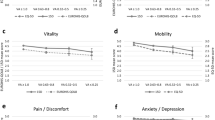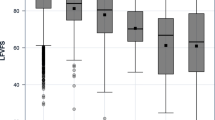Abstract
Purpose
To examine the association of psychosocial adaptation status with vision-specific health-related quality of life (HRQOL) and the role of psychosocial adaptation in the linkage between visual impairment and vision-specific HRQOL outcomes among older adults with visual disorders.
Design and methods
In this cross-sectional study, older urban adults with visual problems (N = 167) were interviewed using a structured questionnaire to assess their self-reported visual function, general health, psychosocial adaptation status, and vision-specific HRQOL. Performance-based measure of visual function marked by distance visual acuity was clinically conducted by ophthalmologists.
Results
It was found in the study that psychosocial adaptation status was significantly associated with vision-specific HRQOL, including the domains of mental health symptoms due to vision and dependency on others due to vision. The results also showed that psychosocial adaptation status could buffer the effect of visual impairment on vision-specific HRQOL, including the domains of social function, mental health, and dependency.
Conclusion
Psychosocial adaptation status is significantly associated with multiple domains of vision-specific HRQOL. The findings have significant implications for health education and psychosocial intervention for older adults with age-related vision loss.
Similar content being viewed by others
References
Michon, J. J., Lau, J., Chan, W. S., & Ellwein, L. B. (2002). Prevalence of visual impairment, blindness, and cataract surgery in the Hong Kong elderly. British Journal of Ophthalmology, 86(2), 133–139.
Coleman, A. L., Stone, K., Ewing, S. K., Nevitt, M., Cummings, S., Cauley, J. A., et al. (2004). Higher risk of multiple falls among elderly women who lose visual acuity. Ophthalmology, 111(5), 857–862.
Haymes, S. A., Johnston, A. W., & Heyes, A. D. (2002). Relationship between vision impairment and ability to perform activities of daily living. Ophthalmic and Physiological Optics, 22(2), 79–91.
West, C. G., Gildengorin, G., Haegerstrom-Portnoy, G., Schneck, M. E., Lott, L., & Brabyn, J. A. (2002). Is vision function related to physical functional ability in older adults? Journal of the American Geriatrics Society, 50(1), 136–145.
Rovner, B. W., & Shmuelydulitzki, Y. (1997). Screening for depression in low-vision elderly. International Journal of Geriatric Psychiatry, 12(9), 955–959.
Tsai, S. Y., Cheng, C. Y., Hsu, W. M., Su, T. P. T., Liu, J. H., & Chou, P. (2003). Association between visual impairment and depression in the elderly. Journal of the Formosan Medical Association, 102(2), 86–90.
Chou, K. L. (2008). Combined effect of vision and hearing impairment on depression in older adults: Evidence from the English longitudinal study of aging. Journal of Affective Disorders, 106(1–2), 191–196.
Rovner, B. W., Casten, R. J., & Tasman, W. S. (2002). Effect of depression on vision function in age related macular degeneration. Archives of Ophthalmology, 120(8), 1041–1044.
Rovner, B. W., Casten, R. J., Hegel, M. T., & Tasman, W. S. (2006). Minimal depression and vision function in age-related macular degeneration. Ophthalmology, 113(10), 1743–1747.
Rovner, B. W., & Casten, R. J. (2002). Activity loss and depression in age-related macular degeneration. American Journal of Geriatric Psychiatry, 10(3), 305–310.
Walker, J. G., Anstey, K. J., & Lord, S. R. (2006). Psychological distress and visual functioning in relation to vision-related disability in older individuals with cataracts. British Journal of Health Psychology, 11(2), 303–317.
Royer, A. (1998). Life with chronic illness: Social and psychological dimensions. Westport, Conn., London: Praeger.
Livneh, H., & Antonak, R. F. (1997). Psychosocial adaptation to chronic illness and disability. Gaithersburg, Md: Aspen Publishers.
Horowitz, A., & Reinhart, J. P. (1998). Development of the adaptation to age-related vision loss scale. Journal of Visual Impairment and Blindness, 92(1), 30–41.
McKinzie, C. A., Reinhardt, J. P., & Benn, D. (2007). Adaptation to chronic vision impairment: Does African American or Caucasian race make a difference? Research on Aging, 29(2), 144–162.
Tolman, J., Hill, R. D., Kleinschmidt, J. J., & Gregg, C. H. (2005). Psychosocial adaptation to visual impairment and its relationship to depressive affect in older adults with age-related macular degeneration. Gerontologist, 45(6), 747–753.
Livneh, H. (2001). Psychosocial adaptation to chronic illness and disability: A conceptual framework. Rehabilitation Counseling Bulletin, 44(3), 151–160.
Spiro, A., 3rd, & Bosse, R. (2000). Relations between health-related quality of life and well-being: The gerontologist’s new clothes? International Journal of Aging and Human Development, 50(4), 297–318.
Broman, A. T., Munoz, B., Rodriguez, J., Sanchez, R., Quigley, H. A., Klein, R., et al. (2002). The impact of visual impairment and eye disease on vision-related quality of life in a Mexican-American population: Proyecto VER. Invest Ophthalmology & Visual Science, 43(11), 3393–3398.
Chia, E. M., Mitchell, P., Rochtchina, E., Foran, S., & Wang, J. J. (2003). Unilateral visual impairment and health related quality of life: The Blue Mountains Eye Study. British Journal of Ophthalmology, 87(4), 392–395.
Chia, E. M., Wang, J. J., Rochtchina, E., Smith, W., Cumming, R. R., & Mitchell, P. (2004). Impact of bilateral visual impairment on health-related quality of life: The Blue Mountains Eye Study. Invest Ophthalmology & Visual Science, 45(1), 71–76.
Wang, C. W., Chan, C. L. W., Ho, A. H. Y., & Xiong, Z. F. (2008). Social networks and health-related quality of life among Chinese older adults with vision impairment. Journal of Aging and Health, 20(7), 804–823.
Wang, C. W., Chan, C. L. W., Ng, S. M., & Ho, A. H. Y. (2008). The impact of spirituality on health-related quality of life among Chinese older adults with vision impairment. Aging & Mental Health, 12(2), 267–275.
Shrout, P. E. (1998). Measurement reliability and agreement in psychiatry. Statistical Methods in Medical Research, 7(3), 301–317.
Rubin, G. S., West, S. K., Munoz, B., Bandeen-Roche, K., Zeger, S., Schein, O., et al. (1997). A comprehensive assessment of visual impairment in a population of older Americans. The SEE study. Salisbury eye evaluation project. Investigative Ophthalmology & Visual Science, 38(3), 557–568.
Brown, M. M., Brown, G. C., Sharma, S., Landy, J., & Bakal, J. (2002). Quality of life with visual acuity loss from diabetic retinopathy and age-related macular degeneration. Archives of Ophthalmology, 120(4), 481–484.
Mangione, C. M., Lee, P. P., Gutierrez, P. R., Spritzer, K., Berry, S., & Hays, R. D. (2001). Development of the 25-item National Eye Institute Visual Function Questionnaire. Archives of Ophthalmology, 119(7), 1050–1058.
Wang, C. W., Chan, C. L. W., & Jin, H. Y. (2008). Psychometric properties of the Chinese version of the 25-item National Eye Institute Visual Function Questionnaire. Optometry and Vision Science, 85(11), 1091–1099.
Massof, R. W., & Fletcher, D. C. (2001). Evaluation of the NEI visual functioning questionnaire as an interval measure of visual ability in low vision. Vision Research, 41, 397–413.
Baron, R. M., & Kenny, D. A. (1986). The moderator-mediator variable distinction in social psychological research: Conceptual, strategic, and statistical considerations. Journal of Personality and Social Psychology, 51(6), 1173–1182.
Hill, C. L., Gill, T., Taylor, A. W., Daly, A., Grande, E. D., & Adams, R. J. (2007). Psychological factors and quality of life in arthritis: A population-based study. Clinical Rheumatology, 26(7), 1049–1054.
Butler, J., & Ciarrochi, J. (2007). Psychological acceptance and quality of life in the elderly. Quality Life Research, 16(4), 607–615.
Lamoureux, E. L., Hassell, J. B., & Keeffe, J. E. (2004). The determinants of participation in activities of daily living in people with impaired vision. American Journal of Ophthalmology, 137(2), 265–270.
Mangione, C. M., Phillips, R. S., Seddon, J. M., Lawrence, M. G., Cook, E. F., Dailey, R., et al. (1992). Development of the ‘activities of daily vision scale: A measure of visual functional status. Medical Care, 30(12), 1111–1126.
Scott, I. U., Schein, O. D., West, S., Bandeen-Roche, K., Enger, C., & Folstein, M. F. (1994). Functional status and quality of life measurement among ophthalmic patients. Archives of Ophthalmology, 112(3), 329–335.
Brenner, M. H., Curbow, B., Javitt, J. C., Legro, M. W., & Sommer, A. (1993). Vision change and quality of life in the elderly. Response to cataract surgery and treatment of other chronic ocular conditions. Archives of Ophthalmology, 111(5), 680–685.
Mangione, C. M., Phillips, R. S., Lawrence, M. G., Seddon, J. M., Orav, E. J., & Goldman, L. (1994). Improved visual function and attenuation of declines in health-related quality of life after cataract extraction. Archives of Ophthalmology, 112(11), 1419–1425.
Wulsin, L. R., Jacobson, A. L., & Rand, L. I. (1991). Psychosocial correlates of mild visual loss. Psychosomatic Medicine, 53(1), 109–117.
Reinhardt, J. P., & D’Allura, T. (2000). Social support and adjustment to vision impairment across the life span. In B. Silverstone, M. A. Lang, B. Rosinthal, & E. Faye (Eds.), Lighthouse handbook on vision impairment and vision rehabilitation (pp. 1049–1068). New York: Oxford University Press.
Acknowledgments
The authors would like to acknowledge and thank Professor Iris Chi and Dr. Chou Kee-Lee for their support and to thank all those who helped to collect the data and those who kindly volunteered to participate in the study.
Author information
Authors and Affiliations
Corresponding author
Rights and permissions
About this article
Cite this article
Wang, CW., Chan, C.L.W. Psychosocial adaptation status and health-related quality of life among older Chinese adults with visual disorders. Qual Life Res 18, 841–851 (2009). https://doi.org/10.1007/s11136-009-9505-z
Received:
Accepted:
Published:
Issue Date:
DOI: https://doi.org/10.1007/s11136-009-9505-z




